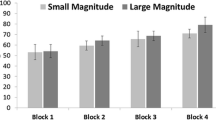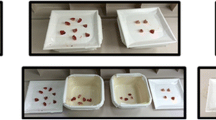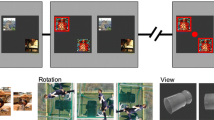Abstract
Conservation of quantity occurs through recognition that changes in the physical arrangement of a set of items do not change the quantity of items in that set. Rhesus monkeys (Macaca mulatta) were presented with a computerized quantity judgment task. Monkeys were rewarded for selecting the greater quantity of items in one of two horizontal arrays of items on the screen. On some trials, after a correct selection, no reward was given but one of the arrays was manipulated. In some cases, this manipulation involved moving items closer together or farther apart to change the physical arrangement of the array without changing the quantity of items in the array. In other cases, additional items were added to the initially smaller array so that it became quantitatively larger. Monkeys then made another selection from the two rows of items. Monkeys were sensitive to these manipulations, changing their selections when the number of items in the rows changed but not when the arrangement only was changed. Therefore, monkeys responded on the basis of the quantity of items, and they were not distracted by non-quantitative manipulations of the sets.


Similar content being viewed by others
References
Beran MJ (2001) Summation and numerousness judgments of sequentially presented sets of items by chimpanzees (Pan troglodytes). J Comp Psychol 115:181–191
Beran MJ (2004a) Chimpanzees (Pan troglodytes) respond to nonvisible sets after one-by-one addition and removal of items. J Comp Psychol 118:25–36
Beran MJ (2004b) Long-term retention of the differential values of Arabic numerals by chimpanzees (Pan troglodytes). Anim Cogn 7:86–92
Beran MJ, Beran MM (2004) Chimpanzees remember the results of one-by-one addition of food items to sets over extended time periods. Psychol Sci 15:94–99
Beran MJ, Beran MJ, Harris EH, Washburn DA (2005) Ordinal judgments and summation of nonvisible sets of food items by two chimpanzees (Pan troglodytes) and a rhesus macaque (Macaca mulatta). J Exp Psychol Anim Behav Proc 31:351–362
Beran MJ, Rumbaugh DM (2001) “Constructive” enumeration by chimpanzees (Pan troglodytes) on a computerized task. Anim Cogn 4:81–89
Beran MJ, Rumbaugh DM, Savage-Rumbaugh ES (1998) Chimpanzee (Pan troglodytes) counting in a computerized testing paradigm. Psychol Record 48:3–19
Biro D, Matsuzawa T (2001) Use of numerical symbols by the chimpanzee (Pan troglodytes): Cardinals, ordinals, and the introduction of zero. Anim Cogn 4:193–199
Boysen ST, Berntson GG (1989) Numerical competence in a chimpanzee (Pan troglodytes). J Comp Psychol 103:23–31
Boysen ST, Capaldi EJ (1993) The development of numerical competence: animal and human models. Erlbaum, Hillsdale, NJ
Call J (2000) Estimating and operating on discrete quantities in orangutans (Pongo pygmaeus). J Comp Psychol 114:136–147
Call J, Rochat P (1997) Perceptual strategies in the estimation of physical quantities by orangutans (Pongo pygmaeus). J Comp Psychol 111:315–329
Czerny P, Thomas RK (1975) Sameness-difference judgments in Saimiri sciureus based on volumetric cues. Anim Learn Behav 3:375–379
Davis H, Bradford SA (1986) Counting behavior by rats in a simulated natural environment. Ethology 73:265–280
Davis H, Perusse R (1988) Numerical competence in animals: definitional issues, current evidence, and a new research agenda. Behav Brain Sci 11:561–615
Elkind D (1968) Piaget's conservation problems. In: Siegel IW, Hooper FH (eds) Logical thinking in children: research based on Piaget's theory. Holt, Rinehart, & Winston, New York, pp 460–472
Emmerton J, Lohmann A, Niemann J (1997) Pigeons’ serial ordering of numerosity with visual arrays. Anim Learn Behav 25:234–244
Flombaum JI, Junge JA, Hauser MD (2005) Rhesus monkeys (Macaca mulatta) spontaneously compute addition operations over large numbers. Cognition 97:315–325
Harris EH, Washburn DA (2005) Macaques’ (Macaca mulatta) use of numerical cues in maze trials. Anim Cogn 8:190–199
Hauser MD, Carey S (2003) Spontaneous representations of small numbers of objects by rhesus macaques: examinations of content and format. Cogn Psychol 47:367–401
Hauser MD, Carey S, Hauser LB (2000) Spontaneous number representation in semi-free-ranging rhesus monkeys. Proc Roy Soc Lon Ser B 267:829–833
Hauser MD, MacNeilage P, Ware M (1996) Numerical representation in primates. Proc Natl Acad Sci USA 93:1514–1517
Judge PG, Evans TA, Vyas DK (2005) Ordinal representation of numeric quantities by brown capuchin monkeys (Cebus apella). J Exp Psychol Anim Behav Proc 31:79–94
Kitchen DM (2004) Alpha male black howler monkey responses to loud calls: effect of numeric odds, male companion behaviour and reproductive investment. Anim Behav 67:125–139
Matsuzawa T (1985) Use of numbers by a chimpanzee. Nature 315:57–59
McGarrigle J, Donaldson M (1974) Conservation accidents. Cognition 3:341–350
Mehler J, Bever TG (1967) Cognitive capacity of very young children. Science 158:141–142
Menzel EW (1961) Perception of food size in the chimpanzee. J Comp Physiol Psychol 54:588–591
Menzel EW, Davenport RK (1962) The effects of stimulus presentation variables upon chimpanzee's selection of food by size. J Comp Physiol Psychol 55:235–239
Menzel EW, Draper WA (1965) Primate selection of food by size: visible versus invisible rewards. J Comp Physiol Psychol 59:231–239
Muncer SJ (1983) “Conservations” with a chimpanzee. Dev Psychol 16:1–11
Nieder A, Miller EK (2004) Analog numerical representations in rhesus monkeys: evidence for parallel processing. J Cogn Neuro 16:889–901
Olthof A, Iden CM, Roberts WA (1997) Judgments of ordinality and summation of number symbols by squirrel monkeys (Saimiri sciureus). J Exp Psychol Anim Behav Proc 23:325–339
Pepperberg IM (1994) Numerical competence in an African Grey parrot (Psittacus erithacus). J Comp Psychol 108:36–44
Piaget J (1965) The child's conception of number. Norton, New York
Richardson WK, Washburn DA, Hopkins WD, Savage-Rumbaugh ES, Rumbaugh DM (1990) The NASA/LRC Computerized Test System. Behavior Research Methods, Instruments, and Computers 22:127–131
Roberts WA, Coughlin R, Roberts S (2000) Pigeons flexibly time or count on cue. Psychol Sci 11:218–222
Roberts WA, Roberts S, Kit KA (2002) Pigeons presented with sequences of light flashes use behavior to count but not to time. J Exp Psychol Anim Behav Proc 28:137–150
Rumbaugh DM, Hopkins WD, Washburn DA, Savage-Rumbaugh ES (1989) Lana chimpanzee learns to count by “NUMATH”: a summary of a videotaped experimental report. Psychol Rec 39:459–470
Smith BR, Piel AK, Candland DK (2003) Numerity of a socially housed hamadryas baboon (Papio hamadryas) and a socially housed squirrel monkey (Saimiri sciureus). J Comp Psychol 117:217–225
Suda C, Call J (2004) Piagetian liquid conservation in the great apes (Pan paniscus, Pan troglodytes, and Pongo pygmaeus). J Comp Psychol 118:265–279
Suda C, Call J (2005) Piagetian conservation of discrete quantities in bonobos (Pan paniscus), chimpanzees (Pan troglodytes), and orangutans (Pongo pygaeus). Anim Cogn 8:220–235
Suda C, Call J (2006). What does an intermediate success rate mean? An analysis of a Piagetian liquid conservation task in the great apes. Cognition 99:53–71
Sulkowski GM, Hauser MD (2001) Can rhesus monkeys spontaneously subtract? Cognition 79:239–262
Thomas RK, Chase L (1980) Relative numerousness judgments by squirrel monkeys. Bull Psychol Soc 16:79–82
Thomas RK, Peay L (1976) Length judgments by squirrel monkeys: evidence for conservation? Dev Psychol 12:349–352
Thomas RK, Walden EL (1985) The assessment of cognitive development in human and nonhuman primates. In: Watts ES (ed) Nonhuman primate models for human growth and development. Alan R. Liss, Inc., New York, pp 187–215
Tomonaga M, Matsuzawa T (2002) Enumeration of briefly presented items by the chimpanzee (Pan troglodytes) and humans (Homo sapiens). Anim Learn Behav 30:143–157
Washburn DA, Hopkins WD, Rumbaugh DM (1989) Video-task assessment of learning and memory in macaques (Macaca mulatta): effects of stimulus movement on performance. J Exp Psychol Anim Behav Proc 15:393–400
Washburn DA, Rumbaugh DM (1991) Ordinal judgments of numerical symbols by macaques (Macaca mulatta). Psychol Sci 2:190–193
Wilson ML, Hauser MD, Wrangham RW (2001) Does participation in intergroup conflict depend on numerical assessment, range location, or rank for wild chimpanzees? Anim Behav 61:1203–1216
Woodruff G, Premack D, Kennel K (1978) Conservation of liquid and solid quantity by the chimpanzee. Science 202:991–994
Xia L, Emmerton J, Siemann M, Delius JD (2001) Pigeons (Columba livia) learn to link numerosities with symbols. J Comp Psychol 115:83–91
Xia L, Siemann M, Delius JD (2000) Matching of numerical symbols with number of responses by pigeons. Anim Cogn 3:35–43
Acknowledgements
This research was supported by National Institutes of Health Grant HD-38051 to the Language Research Center of Georgia State University. The author thanks Ted Evans and Tim Flemming for their comments on an earlier version of this paper and Betty Chan for assistance with the electronic supplementary material. All applicable institutional rules and regulations regarding animal care and use have been followed in the care and testing of the monkeys, and the experiment complied with all laws of the United States of America.
Author information
Authors and Affiliations
Corresponding author
Electronic supplementary material
10071_2006_28_MOESM1_ESM.mpeg.
S1 shows the initial presentation of a 7 versus 5 comparison. After selecting the set of 7, the set of 5 moves outward to increase its length but not its quantity. Here, conservation of quantity would dictate again selecting the bottom set.
10071_2006_28_MOESM2_ESM.mpeg.
S2 shows the initial presentation of a 3 versus 5 comparison. After selecting the set of 5, 4 new items are added to the set of 3, and the correct response is now to pick the top set which has increased in quantity.
Rights and permissions
About this article
Cite this article
Beran, M.J. Rhesus monkeys (Macaca mulatta) succeed on a computerized test designed to assess conservation of discrete quantity. Anim Cogn 10, 37–45 (2007). https://doi.org/10.1007/s10071-006-0028-5
Received:
Revised:
Accepted:
Published:
Issue Date:
DOI: https://doi.org/10.1007/s10071-006-0028-5




